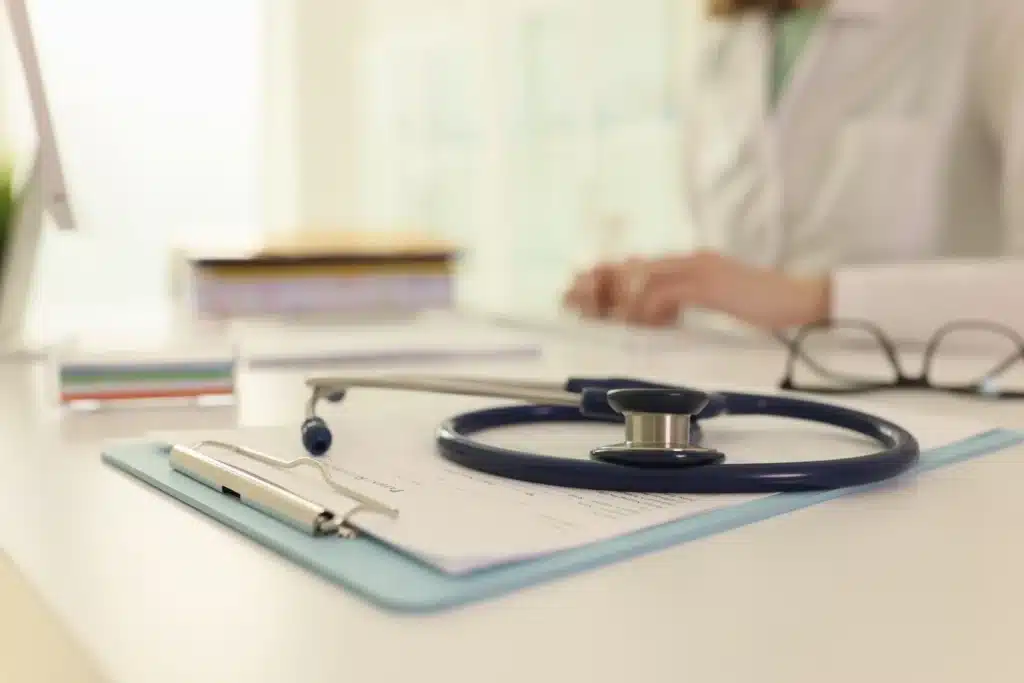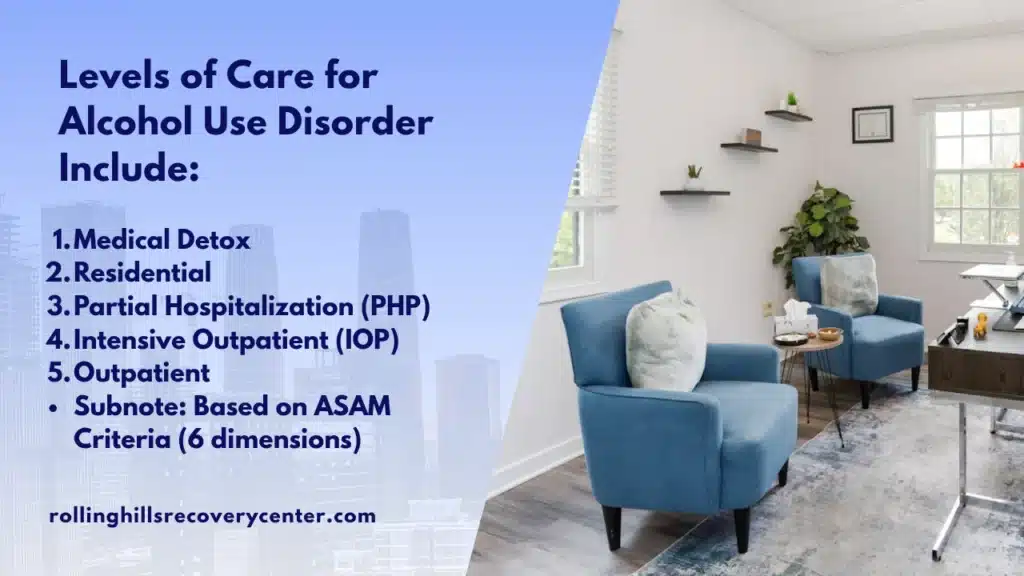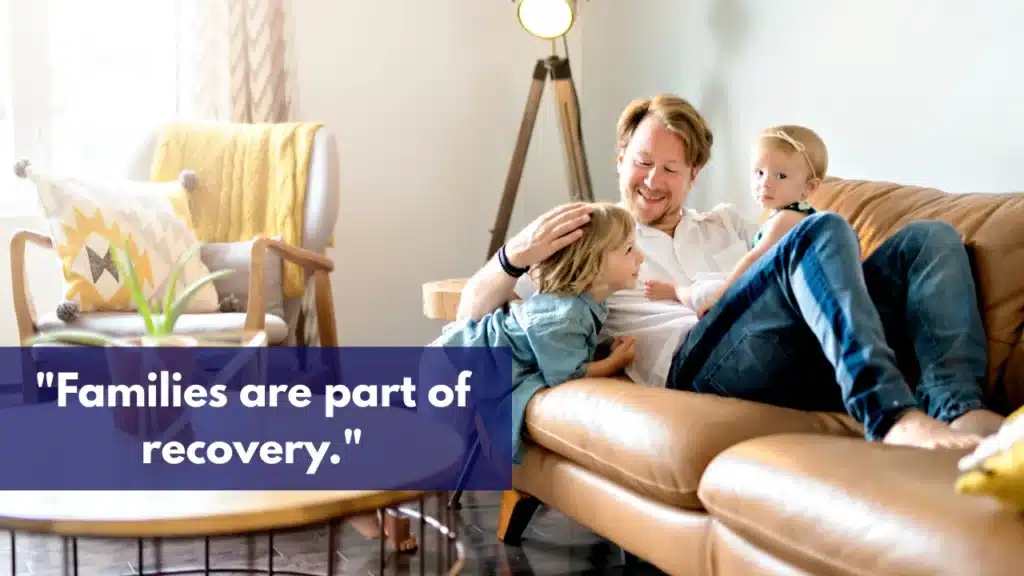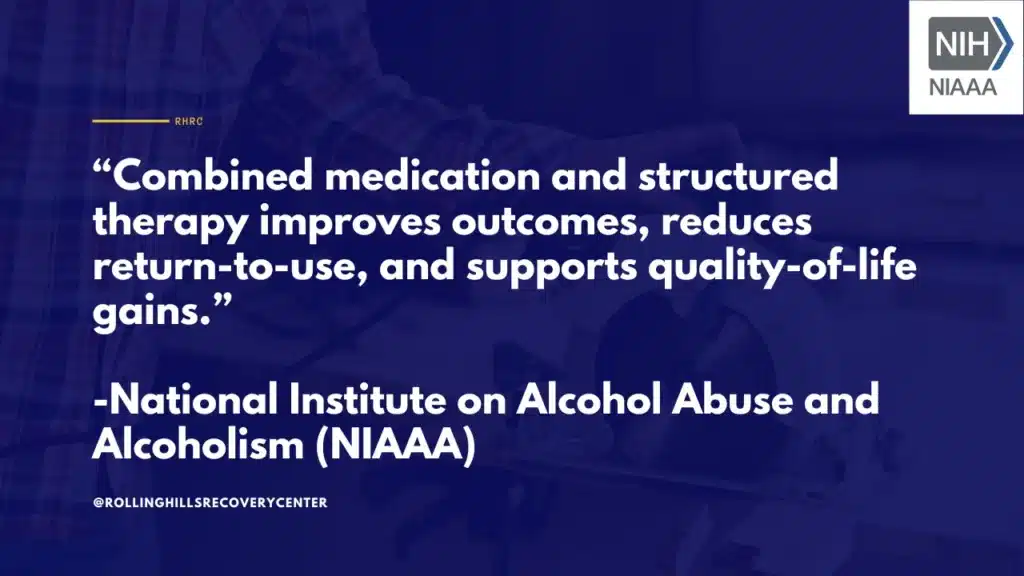Alcohol use disorder is treatable. From a specialist’s view, effective care in New Jersey blends medical detox, evidence-based therapy, and appropriate medication, with 24/7 monitoring when needed.
This overview explains levels of care, co-occurring mental health support, admissions & insurance basics, and aftercare planning, so individuals & families understand what safe, accountable treatment should include.
Key Takeaways
- Safe care in NJ means licensed programs with physician oversight, 24/7 nursing when needed, and FDA‑approved MAT like naltrexone, acamprosate, or disulfiram; plus CBT, motivational work, and relapse prevention.
- Right level at the right time, medical detox and stabilization when withdrawal risk is high; then residential, PHP, IOP, or outpatient per ASAM. Co‑occurring depression, anxiety, and PTSD are treated alongside AUD.
- Families matter, and so does aftercare: education, boundary setting, early discharge planning, MAT maintenance, therapy skills, telehealth check‑ins, and alumni connections to keep progress going.
- Access and cost: confidential assessments, benefits verification, and pre‑auth, clear estimates; parity laws support behavioral health coverage, ask for timelines from first call to admission.
Overview of an Alcoholism Treatment Program
Mission and Care Model
Alcoholism treatment exists to help people achieve safer use goals or abstinence, restore health, and rebuild daily functioning. At Rolling Hills Recovery Center in New Jersey, the clinical mission is simple: evidence-based addiction medicine joined with practical, person-centered care.
The team uses therapies that have strong research support and adds holistic services when they help engagement or comfort. The focus is on what works, delivered with respect.
Treatment plans are individualized. Care begins with a biopsychosocial assessment and a clear diagnosis using DSM-5 criteria for alcohol use disorder (AUD).
From there, clinicians and the patient co-create a plan that addresses alcohol use, mental health, medical needs, family dynamics, and relapse risks.
This is not one-size-fits-all. It is built around the person’s goals and readiness for change.
Medical Supervision and Staffing
Alcohol withdrawal can be life-threatening in moderate to severe cases. That’s why medical supervision is central. Addiction-trained physicians oversee detox and medication decisions. Where the level of care requires it, nursing coverage is 24/7 for observation, symptom management, and safety checks.
Nurse practitioners and physician assistants may handle day-to-day medication adjustments. Licensed therapists lead individual and group therapy. Case managers coordinate family sessions, school or work notes when needed, and aftercare.
Board-certified addiction medicine oversight ensures that medication-assisted treatment (MAT), withdrawal protocols, and psychiatric care follow best practices. In New Jersey, competent facilities also maintain on-call medical coverage at all times, directly or through a physician group.
When specialized needs arise, such as pregnancy, complex withdrawal history, liver disease, or seizure risk, patients are escalated to higher medical monitoring.
Accreditation and New Jersey Licensing
In NJ, facilities must be licensed by the Department of Human Services, Division of Mental Health and Addiction Services (DMHAS). Licensure confirms compliance with state regulations on staffing, safety, confidentiality, and clinical operations.
Many programs also seek accreditation from recognized bodies (for example, The Joint Commission or CARF) to show adherence to national quality standards; patients should ask to see current certificates.
Rolling Hills Recovery Center follows NJ regulations and aligns policies with national guidelines. Patients are provided a HIPAA Notice of Privacy Practices, consent forms, and clear grievance procedures. Laboratory testing and emergency transfers follow state requirements.
Evidence-Based Care, MAT Options, and National Frameworks
Clinical pathways are organized around national frameworks such as:
- The NIAAA Alcohol Treatment Navigator, which helps identify high-quality care and emphasizes evidence-based treatment and shared decision-making. See the Navigator at https://alcoholtreatment.niaaa.nih.gov
- The ASAM Criteria guide level-of-care placement and continued-stay decisions based on six assessment dimensions. See an overview at https://www.asam.org/asam-criteria
MAT options include oral or extended-release (XR) naltrexone, acamprosate, and disulfiram. Selection is based on goals, liver function, adherence patterns, contraindications, and patient preference.
For some, off-label adjuncts may be considered by the medical team when evidence and safety allow.
Medications are paired with counseling. The evidence is consistent: combined MAT and structured therapy improves outcomes, reduces return-to-use risk, and supports quality-of-life gains.
24/7 Nursing Where Indicated and Withdrawal Safety

Alcohol withdrawal ranges from mild to severe, with potential complications such as seizures or delirium tremens. Facilities that provide medical detox maintain 24/7 nursing and rapid access to a provider who can prescribe benzodiazepine-based or alternative protocols (for example, symptom-triggered regimens guided by CIWA-Ar scoring).
Vital signs, fluids, thiamine, magnesium when indicated, and seizure precautions are standard. For mild withdrawal, outpatient or ambulatory detox may be safe when tightly supervised. The ASAM Criteria and clinical judgment determine the setting.
When a person has a history of complicated withdrawal, co-occurring benzodiazepine use, or unstable medical or psychiatric conditions, inpatient withdrawal management is the safer choice. Rolling Hills Recovery Center evaluates each case for the least restrictive, safe level of care.
Context for New Jersey
No prior search results are assumed here, so the clinical outline leans on national standards and NJ regulations. For state context on AUD trends and risks, see alcoholism in New Jersey, which reviews local data, risk factors, and care access patterns that can influence treatment planning and aftercare.
Levels of Care and Core Services

Levels of Care at a Glance
| Level of care | Setting | Daily therapy, MAT initiation, medical care, skills practice, and relapse prevention | Core services | Best fit |
|---|---|---|---|---|
| Medical detox and stabilization (WM) | Inpatient or ambulatory with medical oversight | 3–7 days (varies) | 24/7 monitoring where indicated, withdrawal meds, labs, vitals, safety | Moderate to severe withdrawal risk, medical/psychiatric instability |
| Inpatient/residential | 24-hour structured setting | 2–4 weeks, sometimes longer | Stepping down from inpatient or high-intensity outpatient needs | High relapse risk, unsafe home setting, need for intensive structure |
| Partial Hospitalization (PHP) | Day program 5–6 days/week | 2–4 weeks | 5–6 hours/day therapy, med management, MAT, family work | Moderate support needed with stable housing |
| Intensive Outpatient (IOP) | 3–5 days/week, evenings available | 6–12 weeks | 9–15 hours/week therapy, med management, skills practice | Moderate support need with stable housing |
| Outpatient (OP) | 1–2 visits/week | Ongoing | Individual therapy, med follow-ups, relapse prevention | Mild AUD, maintenance care, or aftercare |
Placement is determined using ASAM dimensions: acute intoxication/withdrawal, biomedical conditions, emotional/behavioral conditions, readiness to change, relapse/continued use potential, and recovery environment.
Medical Detox and Stabilization
Detox addresses the immediate biological risks of stopping alcohol. A standard approach includes:
- Pre-detox assessment: medical history, substance history, CIWA-Ar score, vitals, and lab work as needed.
- Medication strategy: symptom-triggered benzodiazepines (or fixed-dose for certain cases), thiamine before glucose, and adjuncts for autonomic symptoms or sleep.
- Nursing observation: monitoring for seizure risk, delirium, or electrolyte issues; hydration and nutrition support.
- Early MAT planning: naltrexone or acamprosate are discussed once medically appropriate; disulfiram is considered if supervised adherence is possible and desired.
- Discharge to the next level of care: inpatient/residential, PHP, or IOP, depending on stability and supports.
Rolling Hills Recovery Center approaches detox as the first step, not the whole treatment. The hand-off to detox is planned from day one.
Inpatient and Residential Treatment
When someone needs a structured, 24-hour setting, residential care allows rapid behavior change, removal from triggers, and full-day clinical programming. Therapies include individual therapy, CBT skills groups, motivational enhancement techniques, and family sessions.
If trauma is present, a trauma-informed approach is standard, safety first, do no harm, and avoid pushing trauma processing too early in recovery.
Medical providers continue medication management. For patients starting XR-naltrexone, timing is coordinated with the last alcohol use, withdrawal completion, and hepatic screening.
Disulfiram, when chosen, is integrated with observed dosing and education around interactions. Acamprosate is useful for those with liver concerns or who prefer a non-aversive option.
PHP, IOP, and Outpatient Care
These levels sustain progress while patients return to normal life roles. PHP provides near-daily engagement; IOP offers intensive evening or daytime sessions while protecting work and family obligations. Outpatient sessions extend relapse prevention and MAT maintenance.
Telehealth can supplement sessions, especially for check-ins, psychoeducation, and medication refills, with in-person visits scheduled as clinically needed.
Across all levels, the facility emphasizes skills practice: coping with cravings, refusal skills, scheduling pleasant activities, sleep hygiene, and building sober routines. Case managers coordinate school or work notes, FMLA paperwork, and connections to recovery-supportive housing when appropriate.
Medication-Assisted Treatment: Naltrexone, Acamprosate, Disulfiram

Medication choice is individualized:
- Naltrexone (oral daily or monthly XR) reduces rewarding effects and craving. Not for those with acute hepatitis or opioid use; screen for opioids.
- Acamprosate helps maintain abstinence by modulating glutamatergic tone. Renal dosing applies. Best started after detox when abstinent.
- Disulfiram creates an aversive reaction with alcohol. Works best with supervision or observed dosing. Requires education on hidden alcohol sources and drug interactions.
MAT is paired with therapy and recovery supports. Adherence strategies include pill boxes, digital reminders, pharmacy sync, and family involvement when consented.
Psychotherapies and Supportive Services
A balanced program blends:
- Cognitive Behavioral Therapy (CBT): identify triggers, restructure thoughts, and practice alternative behaviors.
- Motivational Enhancement Therapy (MET): strengthen motivation, resolve ambivalence, and set achievable goals.
- Family therapy: boundaries, communication skills, and a unified relapse response.
- Peer recovery groups: therapist-led and community options, plus linkage to mutual-help.
- Trauma-informed practices: attention to safety, choice, collaboration, trust, and empowerment. Screening for PTSD, with stepwise treatment planning.
- Holistic supports: mindfulness, basic fitness, nutrition education, and sleep routines when helpful.
Rolling Hills Recovery Center also addresses “high-functioning” patterns. For more on warning signs and risks that are easy to overlook, see what is functional alcoholism.
Safety Planning and Sober-Support Linkages
Every patient completes a written safety plan. This includes personal triggers, early warning signs, coping actions, people to call, and emergency steps. Linkages are arranged to community supports, recovery meetings, and sober activities.
To locate services near home, use the SAMHSA Treatment Locator at https://findtreatment.gov. For comparing program types, the NIAAA Navigator is also helpful.
Co-Occurring Disorders and Family Involvement
Screening and Integrated Psychiatry
Alcohol use disorder often co-occurs with depression, anxiety disorders, PTSD, and bipolar spectrum conditions. Integrated psychiatry is vital. The clinical team utilizes measurement-based care, including the PHQ-9, GAD-7, PCL-5, and mood charts, to monitor progress and adjust treatment accordingly.
Medications are selected for safety with alcohol recovery and MAT. For example, careful hepatic considerations inform antidepressant choice in heavy drinkers with elevated enzymes.
Therapy addresses co-occurring issues alongside AUD. Cognitive processing for trauma, behavioral activation for depression, exposure-based skills when appropriate, and sleep interventions help stabilize symptoms that otherwise drive drinking.
Family Education and Communication Skills

Family members are often confused, exhausted, or unsure how to help. Structured education covers:
- Basics of AUD as a chronic, treatable condition.
- How medications and therapy work together.
- Setting clear boundaries with compassion.
- Communication skills that reduce shame and promote accountability.
- Warning signs of return to use and how to respond constructively.
When consented, families attend sessions, receive updates on aftercare, and learn how to support medication adherence and sober routines. This builds a recovery environment that favors success.
Legal, Employment, and School Coordination
The care team coordinates documentation for work leaves, return-to-work plans, union requirements, and professional licensing boards when applicable. For adolescents and young adults, school coordination helps protect academic status and plan a graded return.
Where legal issues exist, objective reports can document treatment participation and progress. The aim is to reduce external stressors that worsen relapse risk, while maintaining privacy under HIPAA and state law.
Public Health Context
Alcohol harms are common and costly. The Centers for Disease Control and Prevention track health effects and statistics; resources can be reviewed at https://www.cdc.gov/alcohol/index.htm.
This public health lens reinforces why timely treatment, MAT access, and integrated mental health care matter. It also supports employer and school partnerships that reduce stigma and improve outcomes.
Admissions, Insurance and Cost in NJ
How to Start Care in New Jersey (Step-by-Step)
- Call the admissions line. A confidential pre-screen collects contact info, safety concerns, substance history, and immediate medical risks. If there is a seizure risk, severe withdrawal, or suicidal thinking, the clinician may direct the caller to higher-acuity care or emergency evaluation before admission.
- Complete a clinical assessment. This can be via secure telehealth or in person. It covers the ASAM dimensions and medical/psychiatric history. A release is obtained to speak with a family member or physician if helpful.
- Verify benefits. With consent, staff contact the insurer to confirm eligibility, copays, deductibles, and preauthorization requirements. Self-pay quotes are provided transparently.
- Receive a level-of-care recommendation. The team explains why detox, residential, PHP, IOP, or outpatient is indicated, referencing the ASAM Criteria. The patient participates in the decision.
- Schedule admission and transportation. The facility helps coordinate arrival, and when appropriate, same-day or next-day admission is arranged.
For impartial referrals and state-funded options, the NJ Division of Mental Health and Addiction Services offers resources at https://www.nj.gov/humanservices/dmhas/.
What to Bring to Admission
- Photo ID and insurance card
- Current medication list and pill bottles
- Contact info for primary care, psychiatrist, and emergency contact
- Comfortable clothing, basic toiletries (alcohol-free)
- Legal documents or work/school paperwork if coordination is needed
The facility provides a HIPAA Notice of Privacy Practices and consent forms. Items containing alcohol (mouthwash, colognes) are not allowed. Valuables are discouraged.
Timelines, Confidentiality, and Parity Protections
From first call to admission, timelines vary by medical need and bed availability. For withdrawal risk, admission may be same-day. For PHP/IOP, starts are often within 24–72 hours.
All screening and assessments are confidential under HIPAA. Information is shared only with consent or when legally required.
Insurance parity laws require most plans to cover mental health and substance use care comparably to medical/surgical care. Staff help appeal denials and secure preauthorization when needed.
Sliding scale or payment plans may be available for self-pay cases, and NJ state resources can bridge gaps for eligible residents.
Transportation and Referrals
Transportation may be coordinated for safe arrival and discharge. For patients transferring from hospitals or ERs, the team works with sending providers to ensure continuity.
If Rolling Hills Recovery Center is not the right fit, admissions staff will help with referrals through the SAMHSA Treatment Locator or state resources, so care is not delayed.
For a broader context on choosing care in the state, see the best addiction treatment in NJ.
Aftercare and Outcomes

Continuing Care Planning Before Discharge
Discharge planning begins at admission. Every patient leaves with:
- A written continuing care plan with appointments scheduled (therapy, psychiatry, MAT refills).
- A medication plan (for example, next XR-naltrexone injection date or acamprosate dosing).
- A relapse prevention packet: coping skills, trigger map, and a 72-hour recovery schedule that includes sleep, meals, movement, and support meetings.
- Recovery-support links: mutual-help meetings, peer recovery coaching, and telehealth options.
A typical 30-day plan includes weekly therapy, medication management every 2–4 weeks, and at least two peer-support contacts per week. For those in high-risk environments, recommendations may include recovery housing.
Telehealth Check-Ins, Coaching, and Mutual-Help
Telehealth keeps people engaged and reduces logistical barriers. Rolling Hills Recovery Center uses secure platforms for brief check-ins, medication follow-ups, and psychoeducation groups.
Recovery coaching complements therapy by focusing on practical goals: daily structure, social connections, scheduling, and accountability.
Mutual-help is encouraged but tailored to the person. Options include 12-step groups, SMART Recovery, Refuge Recovery, Women for Sobriety, or professional peer groups. Consistency is more important than the specific brand of support.
Return-to-Use Response Plans
A return to use is not a failure; it’s a signal to adjust the plan. Each patient works with the team to outline what to do if alcohol is used:
- Notify a designated contact (therapist, coach, trusted family member).
- Increase visit frequency or step up a level of care temporarily.
- Review and update triggers, with a specific plan for the next 24–72 hours.
- Consider a medication change (for example, add XR-naltrexone) or observed dosing for disulfiram if chosen.
- Re-engage family supports and peer groups promptly.
If safety is at risk, withdrawal history with seizure risk, suicidal thinking, or severe comorbidities, patients are directed to higher-acuity care without delay.
Tracking Outcomes and Continuous Quality Improvement
Objective measures help patients and clinicians see progress:
- Retention: attendance rates, session completion, and medication adherence.
- Alcohol outcomes: percent days abstinent, heavy drinking days, craving scores.
- Functioning: sleep quality, work/school attendance, family satisfaction, legal/employment stability.
- Mental health: PHQ-9, GAD-7, PCL-5 improvements.
These are reviewed at set intervals (for example, 30, 60, 90 days) and inform care adjustments. Aggregated outcomes drive program improvements.
The literature, NIAAA, and the ASAM Criteria frameworks converge on the same point: combined MAT plus structured therapy improves outcomes compared with therapy alone. It reduces heavy drinking days, extends time to first drink, and improves quality of life.
Public health guidance supports this integrated model, especially when access is streamlined, stigma is addressed, and family systems are included.
A Practical Safety Plan Template
Use this quick template with your clinician and family:
- Triggers and early signs: list the top five internal and external triggers and the first warning signs you notice.
- Coping actions: three fast actions you can take in the moment (walk, call, breathing drill, leave location).
- People and numbers: at least three contacts with phone numbers; include a professional contact.
- Environment steps: remove or lock up alcohol, avoid high-risk locations, and plan rides home from events.
- Emergency: when to call 988 or go to the ER; note seizure history or other medical risks on the plan.
Keep a copy on your phone and a paper copy at home. Review weekly for the first 90 days, then monthly.
Alumni Engagement and Community
Alumni touchpoints, recovery events, speaker nights, and online groups reinforce progress and provide mentoring opportunities. When someone moves or changes jobs, telehealth check-ins help bridge gaps until new local supports are in place.
Graduates are invited to share strategies that worked for them, including how they use MAT, what routines keep them steady, and what they wish they had known earlier.
Putting it Together
An effective alcohol treatment program in NJ combines strong medical oversight, evidence-based therapy, and practical supports that fit real life. Rolling Hills Recovery Center’s approach reflects national standards, state licensure requirements, and the science endorsed by NIAAA and ASAM.
Whether someone needs detox, residential stabilization, or flexible outpatient care, the path is built step by step, with safety, medications when helpful, skills training, and consistent follow-up, so gains are not just achieved but maintained.
Conclusion
This piece recapped what safe, effective care for alcohol use disorder in NJ looks like: medical oversight, evidence-based therapy & MAT, plus strong family & aftercare. Key takeaways: Match the level of care to the need, treat co-occurring issues, and plan for recovery from the start. Ready to act? Reach out today to verify insurance and schedule an assessment.
Frequently Asked Questions (FAQs)
What Happens First at an Alcoholism Treatment Facility in New Jersey?
Treatment begins with a confidential clinical assessment to confirm alcohol use disorder, check withdrawal risk, and identify co-occurring mental health needs.
Vital signs, labs when indicated, and a brief medical history help determine the right level of care, detox, residential, partial hospitalization, intensive outpatient, or standard outpatient.
The care plan then outlines evidence-based therapy, medication options like naltrexone or acamprosate, and family involvement. Insurance benefits are verified early so treatment can start without delays.
What Treatments Are Considered Evidence-Based at an Alcoholism Treatment Facility in New Jersey?
Core evidence-based treatments include medication for alcohol use disorder (naltrexone, acamprosate, disulfiram when appropriate), cognitive behavioral therapy, motivational enhancement strategies, relapse prevention training, and family therapy.
When anxiety, depression, PTSD, or bipolar symptoms are present, integrated psychiatric care is added.
Recovery supports, including sleep hygiene, nutrition, peer groups, and sober skill-building, round out comprehensive care. Medication plus therapy tends to outperform either alone.
How Long Does Care Usually Last at an Alcoholism Treatment Facility in New Jersey?
Length of care varies by medical need and progress.
Withdrawal management may take 3–7 days, residential or partial hospitalization often runs 2–4 weeks, intensive outpatient commonly spans 8–12 weeks, and ongoing outpatient or medication visits continue as needed.
Recovery is not a straight line; step-ups or step-downs in level of care happen as symptoms, safety, and stability change over time.
Will Insurance Cover an Alcoholism Treatment Facility in New Jersey?
Most commercial plans and many NJ Medicaid plans cover medically necessary services, including detox, residential, PHP, IOP, outpatient, and medications.
Coverage depends on plan benefits, prior authorization, and medical necessity reviews.
Parity laws support equal coverage for behavioral health & medical conditions, but documentation matters, accurate diagnoses, withdrawal scores, and functional impairments help approvals.
Patients should request benefits verification and clear cost estimates before admission.
Find Your Way to Quality Alcohol Treatment: https://alcoholtreatment.niaaa.nih.gov/
ASAM Criteria: https://www.asam.org/asam-criteria
SAMHSA Treatment Locator: https://findtreatment.gov/
CDC Alcohol Use: https://www.cdc.gov/alcohol/index.html
New Jersey Mental Health and Addiction Services: https://www.nj.gov/humanservices/dmhas/
Author
-
Our editorial team includes licensed clinicians and board-certified addiction specialists. Every article is written and reviewed to be clear, accurate, and rooted in real treatment experience.
View all posts -
Dr. Williams has held senior leadership positions in the behavioral health field for over 30 years. He has worked with diverse populations in various private and public sectors.
View all posts












